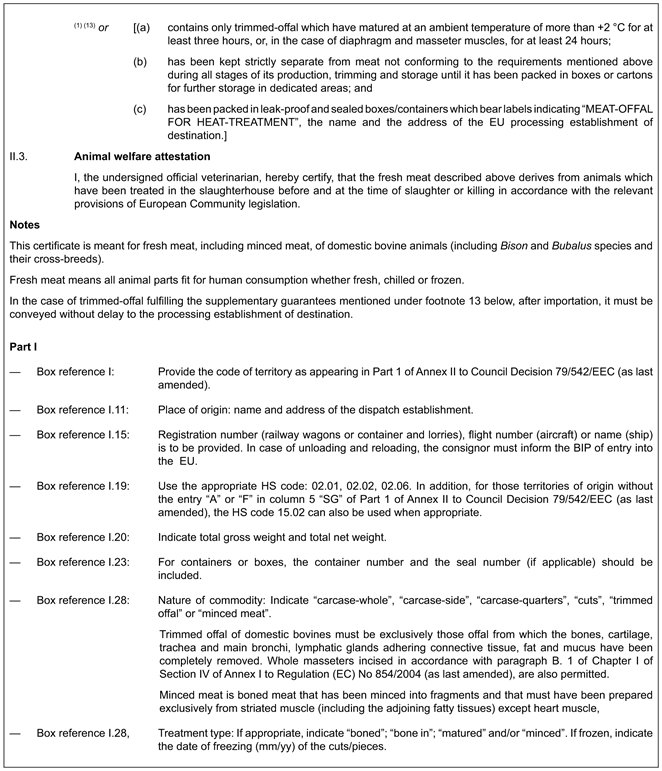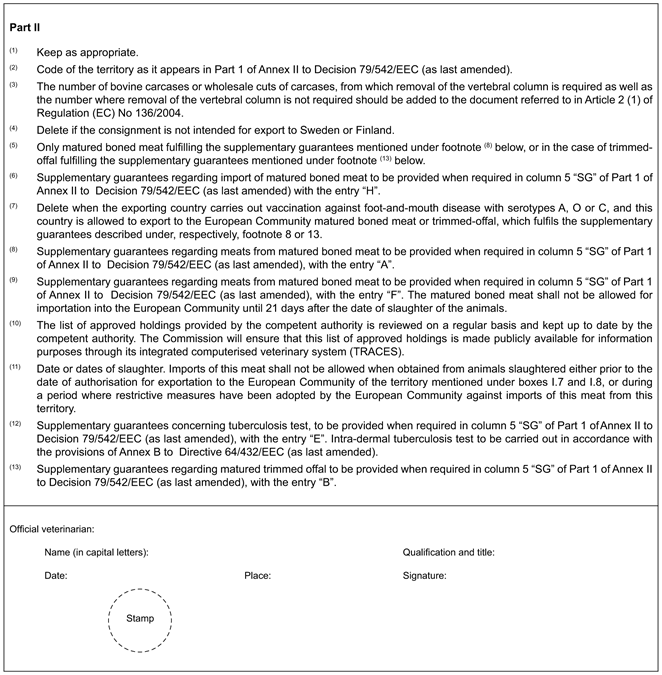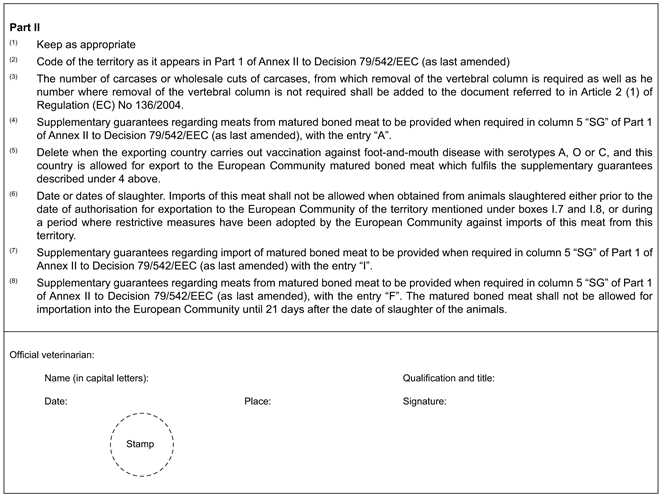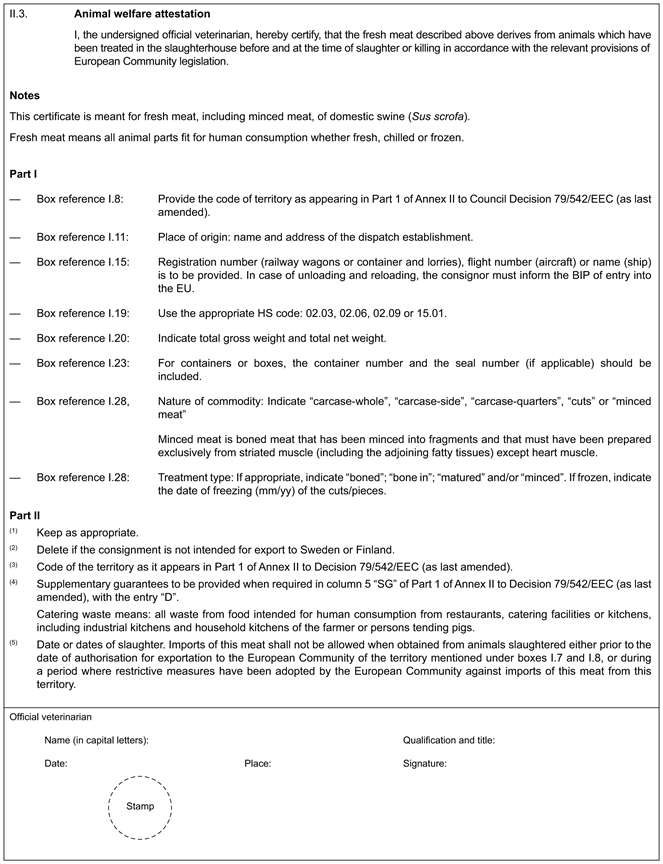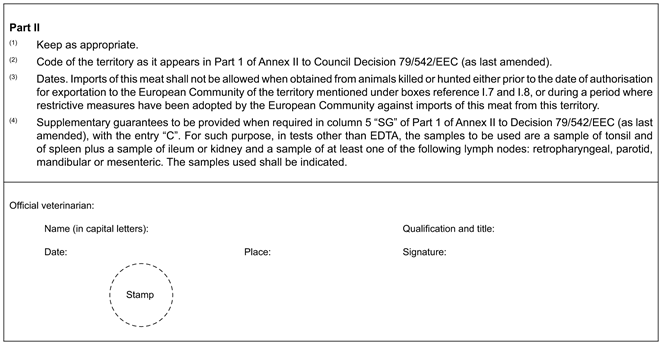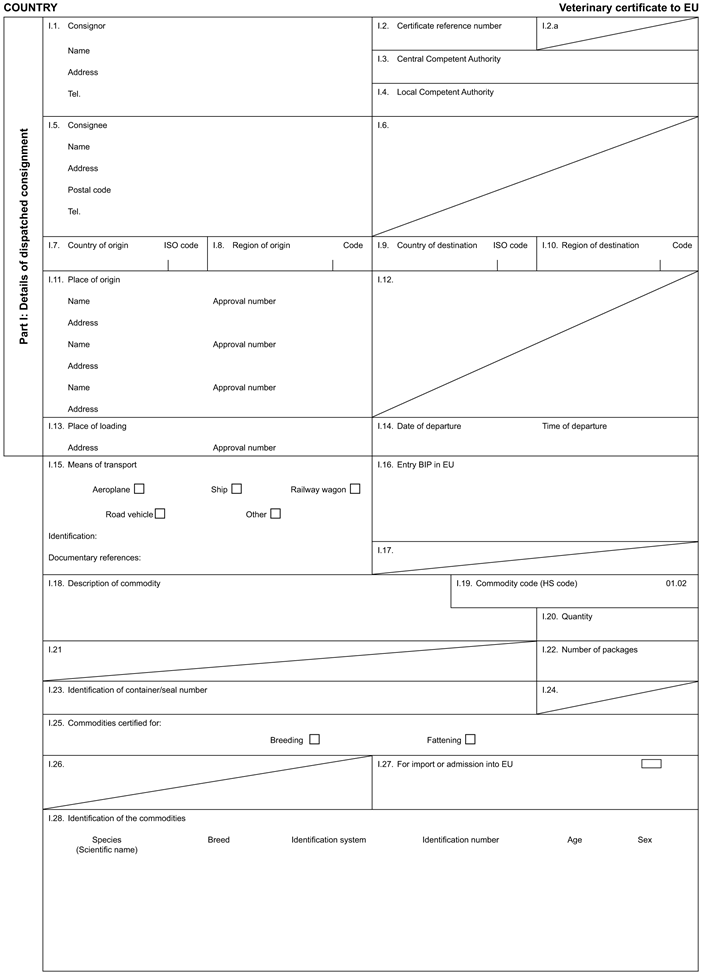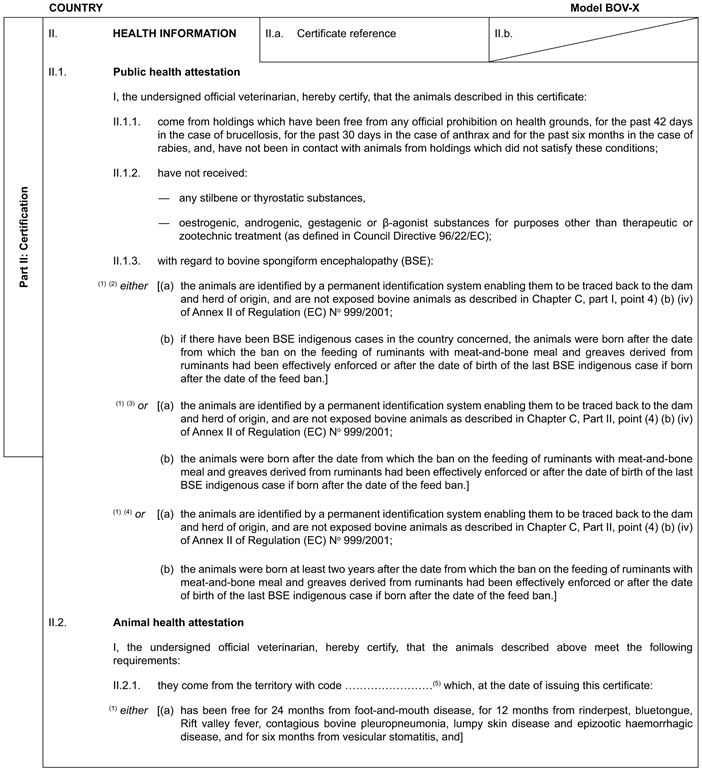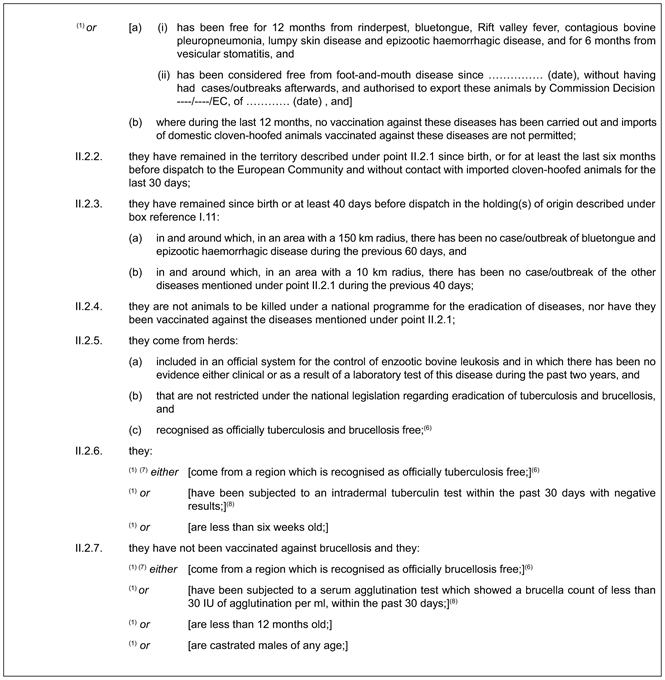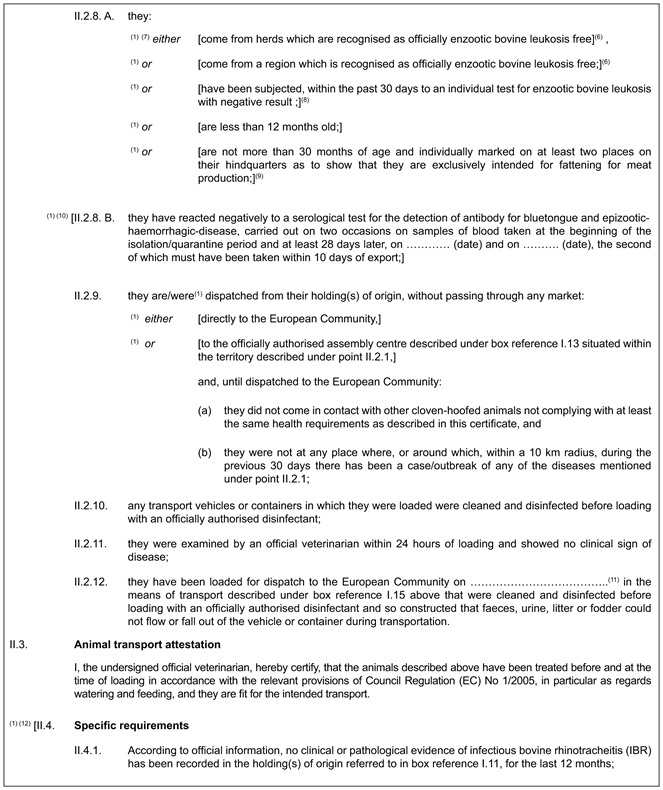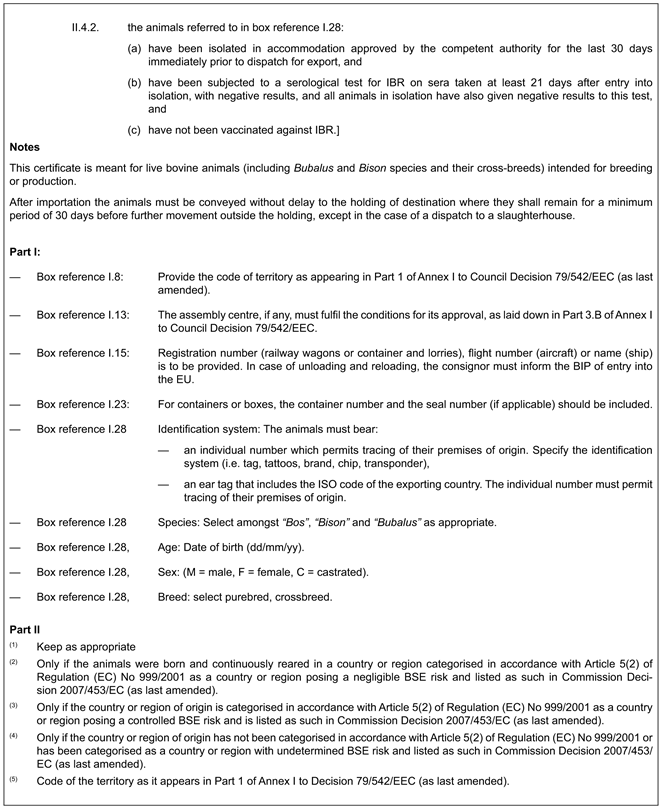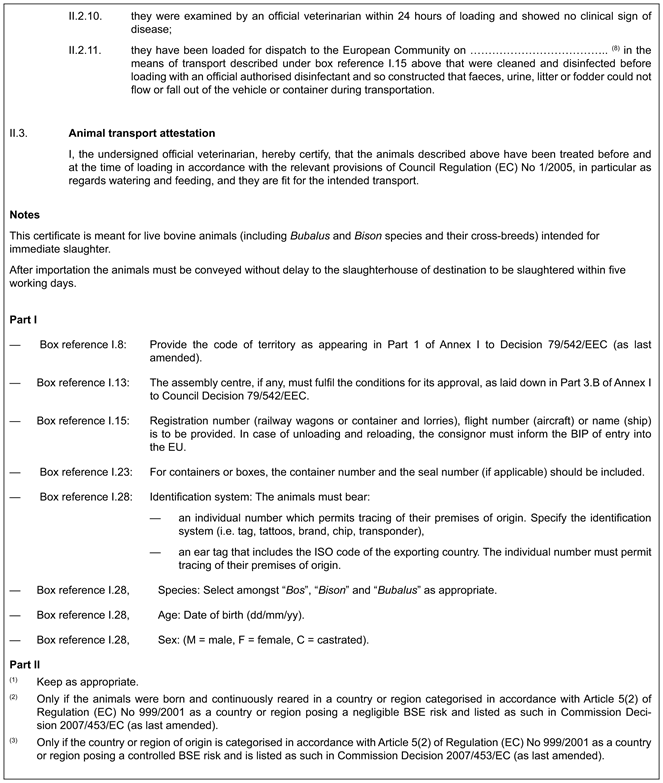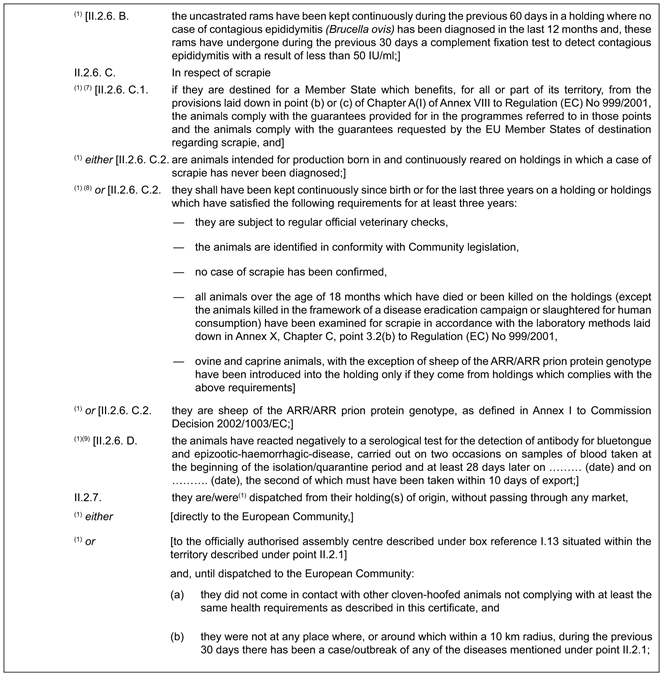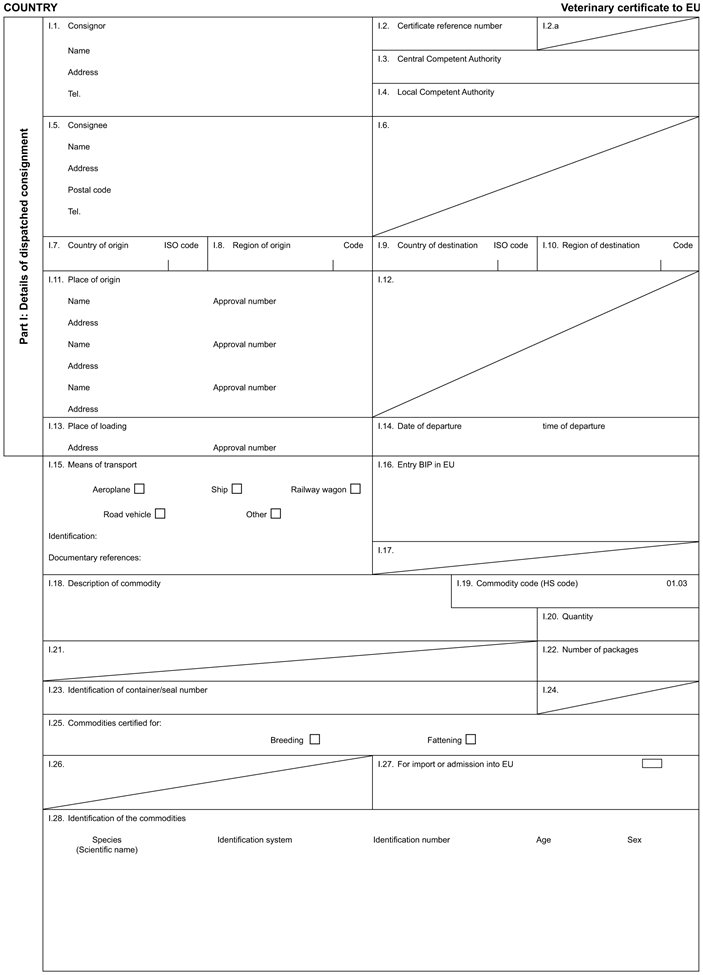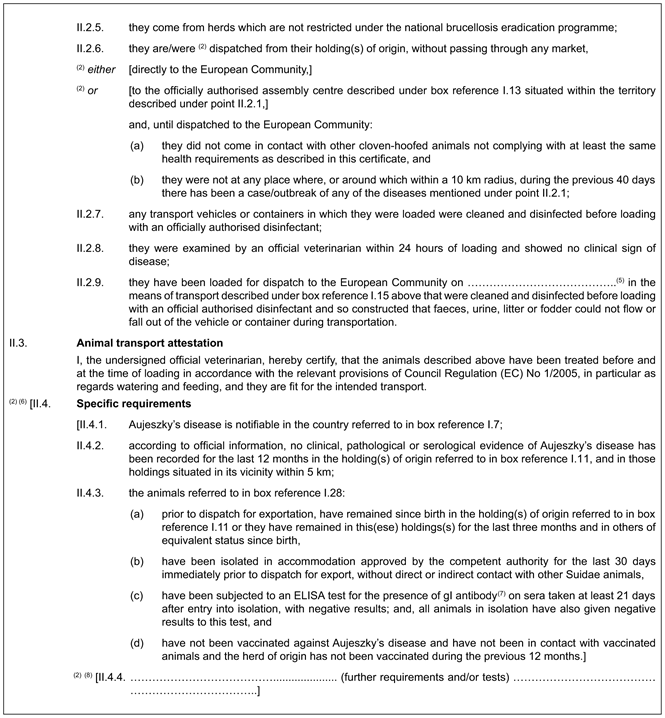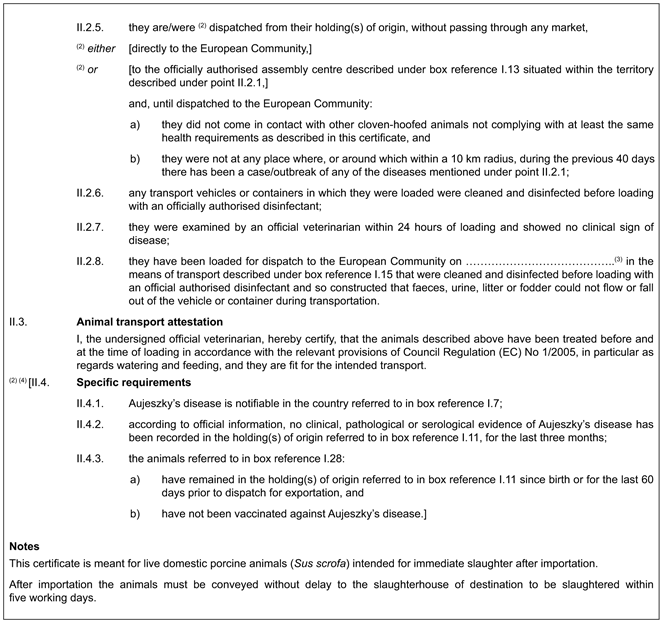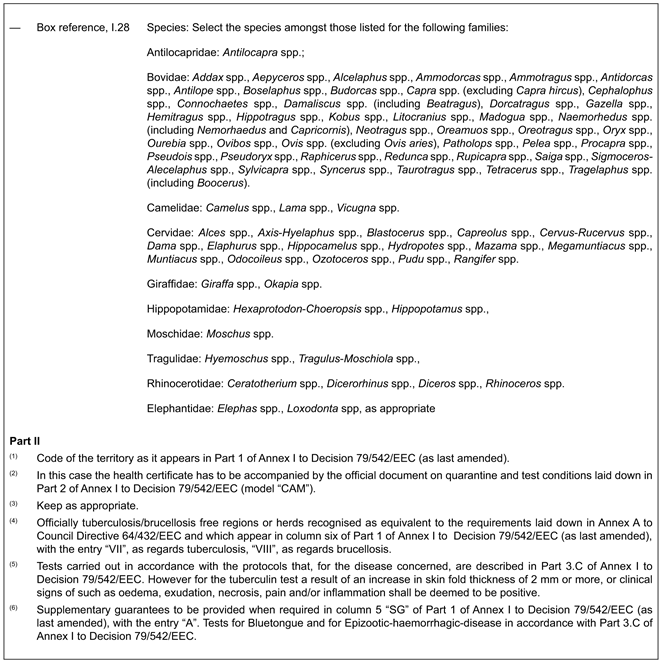- Latest available (Revised)
- Original (As adopted by EU)
Commission Decision of 27 June 2008 amending Annexes I and II to Council Decision 79/542/EEC as regards certification requirements for imports into the Community of certain live ungulate animals and their fresh meat (notified under document number C(2008) 3040) (Text with EEA relevance) (2008/752/EC)
You are here:
More Resources
This is a legislation item that originated from the EU
After exit day there will be three versions of this legislation to consult for different purposes. The legislation.gov.uk version is the version that applies in the UK. The EU Version currently on EUR-lex is the version that currently applies in the EU i.e you may need this if you operate a business in the EU.
The web archive version is the official version of this legislation item as it stood on exit day before being published to legislation.gov.uk and any subsequent UK changes and effects applied. The web archive also captured associated case law and other language formats from EUR-Lex.
Status:
This is the original version (as it was originally adopted).
In Annex I, Parts 1 and 2 are replaced by the following:
ANNEX ILIVE ANIMALS
PART 1
List of third countries or parts thereofa
| a Without prejudice to specific certification requirements provided for by any relevant Community agreement with third countries. | |||||
| b Exclusively for live animals other than animals belonging to the cervidae species. | |||||
| c Certificates in accordance with the agreement between the European Community and the Swiss Confederation on trade in agricultural products (OJ L 114, 30.4.2002, p. 132). | |||||
| d The former Yugoslav Republic of Macedonia; provisional code that does not prejudge in any way the definitive nomenclature for this country, which will be agreed following the conclusion of negotiations currently taking place on this subject in the United Nations. | |||||
| e Not including Kosovo as defined by United Nations Security Council Resolution 1244 of 10 June 1999. | |||||
| Country (a) | Code of territory | Description of territory | Veterinary certificate | Specific conditions | |
|---|---|---|---|---|---|
| Model(s) | SG | ||||
| 1 | 2 | 3 | 4 | 5 | 6 |
| CA — Canada | CA-0 | Whole country | POR-X | IVb IX | |
| CA-1 | Whole country except the Okanagan Valley region of British Columbia described as follows:
| BOV-X, OVI-X, OVI-Y RUMb | A | ||
| CH — Switzerland | CH-0 | Whole country | c | ||
| CL — Chile | CL-0 | Whole country | BOV-X, OVI-X, RUM | ||
| POR-X, SUI | B | ||||
| GL — Greenland | GL-0 | Whole country | OVI-X, RUM | V | |
| HR — Croatia | HR-0 | Whole country | BOV-X, BOV-Y, RUM, OVI-X, OVI-Y | ||
| IS — Iceland | IS-0 | Whole country | BOV-X, BOV-Y RUM, OVI-X, OVI-Y | ||
| POR-X, POR-Y | B | ||||
| ME — Montenegro | ME-0 | Whole country | I | ||
| MK — The former Yugoslav Republic of Macedoniad | MK-0 | Whole country | I | ||
| NZ — New Zealand | NZ-0 | Whole country | BOV-X, BOV-Y, RUM, POR-X, POR-Y OVI-X, OVI-Y | III V | |
| PM — St Pierre Miquelon | PM-0 | Whole country | BOV-X, BOV-Y, RUM, OVI-X, OVI-Y CAM | ||
| RS — Serbiae | RS-0 | Whole country | I | ||
Specific conditions (see footnotes in each certificate)
:
for transit through the territory of animals for direct slaughter which are consigned from a Member State and destined to another Member State in lorries which have been sealed with a serially numbered seal. The seal number must be entered on the health certificate issued in accordance with the model laid down in Annex F to Council Directive 64/432/EEC of 26 June 1964 on animal health problems affecting intra-Community trade in bovine animals and swine, for bovine and swine animals, and in accordance with Model I of Annex E to Council Directive 91/68/EEC of 28 January 1991 on animal health conditions governing intra-Community trade in ovine and caprine animals, for ovine and caprine animals. In addition, the seal must be intact on arrival at the designated border inspection post of entry into the Community and the seal number recorded in TRACES. The certificate must be stamped at the exit point of the Member State of origin by the competent veterinary authorities prior to transiting a third country with the following appropriate wording “ONLY FOR TRANSIT BETWEEN DIFFERENT PARTS OF THE EUROPEAN UNION VIA THE FORMER YUGOSLAV REPUBLIC OF MACEDONIA/MONTENEGRO/SERBIA (delete country as applicable).”
:
territory recognised as having an official tuberculosis-free status for the purposes of exports to the European Community of animals certified according to the model of certificate BOV-X
:
territory recognised as having an official brucellosis-free status for the purposes of exports to the European Community of animals certified according to the model of certificate BOV-X.
:
territory recognised as having an official enzootic-bovine-leukosis (EBL) free status for the purposes of exports to the European Community of animals certified according to the model of certificate BOV-X.
:
territory with approved holdings recognised as having an official enzootic-bovine-leukosis (EBL) free status for the purposes of exports to the European Community of animals certified according to the model of certificate BOV-X.
:
territory recognised as having an official brucellosis-free status for the purposes of exports to the European Community of animals certified according to the model of certificate OVI-X.
:
Geographical constraints.
:
territory recognised as having an official tuberculosis-free status for the purposes of exports to the European Community of animals certified according to the model of certificate RUM.
:
territory recognised as having an official brucellosis-free status for the purposes of exports to the European Community of animals certified according to the model of certificate RUM.
:
territory recognised as having an official Aujeszky’s disease -free status for the purposes of exports to the European Community of animals certified according to the model of certificate POR-X.
PART 2Models of Veterinary Certificates
Models
:
Model of veterinary certificate for domestic bovine animals (including Bubalus and Bison species and their cross-breeds) intended for breeding and/or production after importation.
:
Model of veterinary certificate for domestic bovine animals (including Bubalus and Bison species and their cross-breeds) intended for immediate slaughter after importation.
:
Model of veterinary certificate for domestic sheep (Ovis aries) and goats (Capra hircus) intended for breeding and/or production after importation.
:
Model of veterinary certificate for domestic sheep (Ovis aries) and goats (Capra hircus) intended for immediate slaughter after importation.
:
Model of veterinary certificate for domestic porcine animals (Sus scrofa) intended for breeding and/or production after importation.
:
Model of veterinary certificate for domestic porcine animals (Sus scrofa) intended for immediate slaughter after importation.
:
Model of veterinary certificate for animals of the order Artiodactyla (excluding bovine animals (including Bubalus and Bison species and their cross-breeds), Ovis aries, Capra hircus, Suidae and Tayassuidae), and of the families Rhinocerotidae and Elephantidae.
:
Model of veterinary certificate for non-domestic Suidae, Tayassuidae and Tapiridae.
:
Model of specific attestation for animals imported from St Pierre and Miquelon under the conditions provided for in Part 4 of Annex I.
SG (Supplementary guarantees)
:
guarantees regarding Bluetongue and Epizootic-haemorrhagic-disease tests on animals certified according to the model of certificate BOV-X (point II.2.8 B), OVI-X (point II.2.6 D) and RUM (point II.2.6).
:
guarantees regarding Swine-vesicular-disease and Classical-swine-fever tests on animals certified according to the model of certificate POR-X (point II.2.4 B) and SUI (point II.2.4 B).
:
guarantees regarding Brucellosis test on animals certified according to the model of certificate POR-X (point II.2.4 C) and SUI (point II.2.4 C).
Notes
| (a) Veterinary certificates shall be produced by the exporting country, based on the models appearing in Part 2 of Annex I, according to the layout of the model that corresponds to the animals concerned. They shall contain, in the numbered order that appears in the model, the attestations that are required for any third country and, as the case may be, those supplementary guarantees that are required for the exporting third country or part thereof. If so requested by the EU Member State of destination, for the animals concerned, the additional certification requirements shall be also incorporated in the original form of the veterinary certificate. (b) A separate and unique certificate must be provided for animals that are exported from a single territory appearing in columns 2 and 3 of Part 1 of Annex I which are consigned to the same destination and transported in the same railway wagon, lorry, aircraft or ship. (c) The original of each certificate shall consist of a single page, both sides, or, where more text is required, it shall be in such a form that all pages needed are part of an integrated whole and indivisible. (d) It shall be drawn up in at least one of the official languages of the EU Member State in which the inspection at the border post shall be carried out and of the EU Member State of destination. However, these Member States may allow another Community language instead of their own, accompanied, if necessary, by an official translation. (e) If for reasons of identification of the items of the consignment (schedule in point I.28 of the model of certificate), additional pages are attached to the certificate, these pages shall also be considered as forming part of the original of the certificate by the application of the signature and stamp of the certifying official veterinarian, on each of the pages. | (f) When the certificate, including additional schedules referred to in (e), comprises more than one page, each page shall be numbered — (page number) of (total number of pages) — on its bottom and shall bear the code number of the certificate that has been designated by the competent authority on its top. (g) The original of the certificate must be completed and signed by an official veterinarian within 24 hours prior to loading of the consignment for exportation to the Community. In doing so, the competent authorities of the exporting country shall ensure that principles of certification equivalent to those laid down in Council Directive 96/93/EC are followed. The colour of the signature shall be different to that of the printing. The same rule applies to stamps other than those embossed or watermark. (h) The original of the certificate must accompany the consignment until it reaches the EU border inspection post. (i) The certificate shall be valid for 10 days from the date of issuing. In the case of transport by ship the time of validity is prolonged by the time of the trip in the ship. For this purpose, a declaration by the master of the ship, drawn up in accordance with the addendum of Part 3 of Annex I to this Decision, shall be attached in its original form to the veterinary certificate. (j) Animals shall not be transported together with other animals that, either are not destined to the European Community, or are of a lower health status. (k) During their transport to the European Community, the animals shall not be unloaded in the territory of a country or part of a country that is not approved for imports into the Community of these animals. (l) The certificate reference number referred to in boxes I.2 and II.a. must be issued by the competent authority. |
Specific animal health attestation for animals quarantined in St. Pierre and Miquelon prior to export to the European Community
In Annex II, Part 2 is replaced by the following:
”PART 2Models of veterinary certificates
Model(s)
:
Model of veterinary certificate for fresh meat, including minced meat, of domestic bovine animals (including Bison and Bubalus species and their cross-breeds).
:
Model of veterinary certificate for fresh meat, including minced meat, of domestic sheep (Ovis aries) and goats (Capra hircus).
:
Model of veterinary certificate for fresh meat, including minced meat, of domestic porcine animals (Sus scrofa).
:
Model of veterinary certificate for fresh meat, excluding minced meat, of domestic solipeds (Equus caballus, Equus asinus and their cross-breeds).
:
Model of veterinary certificate for fresh meat, excluding offal and minced meat, of farmed non-domestic animals of the order Artiodactyla (excluding bovine animals (including Bison and Bubalus species and their cross-breeds), Ovis aries, Capra hircus, Suidae and Tayassuidae), and of the families Rhinocerotidae and Elephantidae.
:
Model of veterinary certificate for fresh meat, excluding offal and minced meat, of wild non-domestic animals of the order Artiodactyla (excluding bovine animals (including Bison and Bubalus species and their cross-breeds), Ovis aries, Capra hircus, Suidae and Tayassuidae), and of the families Rhinocerotidae and Elephantidae.
:
Model of veterinary certificate for fresh meat, excluding offal and minced meat, of farmed non-domestic animals belonging to the Suidae, Tayassuidae, or Tapiridae families.
:
Model of veterinary certificate for fresh meat, excluding offal and minced meat, of wild non-domestic animals belonging to the Suidae, Tayassuidae, or Tapiridae families.
:
Model of veterinary certificate for fresh meat, excluding offal and minced meat, of wild solipeds belonging to the subgenus Hippotigris (Zebra).
SG (Supplementary guarantees)
:
guarantees regarding the maturation, pH measurement and boning of fresh meat, excluding offal, certified according to the models of certificates BOV (point II.2.6), OVI (point II.2.6), RUF (point II.2.7) and RUW (point II.2.4).
:
guarantees regarding matured trimmed offal as described in the model of certificate BOV (point II.2.6).
:
guarantees regarding laboratory test for classical-swine-fever in the carcases from which fresh meat certified according to the model of certificate SUW (point II.2.3 B) was obtained.
:
guarantees regarding swill feed on holding(s) of animals from which fresh meat certified according to models of certificate POR (point II.2.3 d) was obtained.
:
guarantees regarding tuberculosis test in the animals from where fresh meat certified according to the model of certificate BOV (point II.2.4 d) was obtained.
:
guarantees regarding the maturation and de-boning of fresh meat, excluding offal, certified according to the models of certificates BOV (point II.2.6), OVI (point II.2.6), RUF (point II.2.6) and RUW (point II.2.7).
:
guarantees regarding 1, exclusion of offals and spinal cord; and 2, testing and origin of cervid animals in relation to chronic wasting disease as referred to in the models of certificates RUF (point II.1.9) and RUW (point II.1.10).
:
supplementary guarantees required for Brazil concerning animal contacts, vaccination programmes and surveillance. However as the State of Santa Catarina in Brazil does not vaccinate against foot-and-mouth disease, the reference to a vaccination programme is not applicable for meat coming from animals originating and slaughtered in that State.
Notes
| (a) Veterinary certificates shall be produced by the exporting country, based on the models appearing in Part 2 of Annex II, according to the layout of the model that corresponds to the meats concerned. They shall contain, in the numbered order that appears in the model, the attestations that are required for any third country and, as the case may be, those supplementary guarantees that are required for the exporting third country or part thereof. (b) A separate and unique certificate must be provided for meat that is exported from a single territory appearing in columns 2 and 3 of Part 1 of Annex II which is consigned to the same destination and transported in the same railway wagon, lorry, aircraft or ship. (c) The original of each certificate shall consist of a single page, both sides, or, where more text is required, it shall be in such a form that all pages needed are part of an integrated whole and indivisible. (d) It shall be drawn up in at least one of the official languages of the EU Member State in which the inspection at the border post shall be carried out and of the EU Member State of destination. However, these Member States may allow other languages, if necessary, accompanied by an official translation. | (e) If for reasons of identification of the items of the consignment (schedule in point I.28 of the model of certificate), additional pages are attached to the certificate, these pages shall also be considered as forming part of the original of the certificate by the application of the signature and stamp of the certifying official veterinarian, in each of the pages. (f) When the certificate, including additional schedules referred to in (e), comprises more than one page, each page shall be numbered — (page number) of (total number of pages) — at the bottom and shall bear the code number of the certificate that has been designated by the competent authority at the top. (g) The original of the certificate must be completed and signed by an official veterinarian. In doing so, the competent authorities of the exporting country shall ensure that the principles of certification equivalent to those laid down in Council Directive 96/93/EC are followed. The colour of the signature shall be different to that of the printing. The same rule applies to stamps other than those embossed or watermarked. (h) The original of the certificate must accompany the consignment at the EU border inspection post. (i) The certificate reference number referred to in boxes I.2 and II.a must be issued by the competent authority. |
Options/Help
Print Options
PrintThe Whole Decision
PrintThe Whole Annex
Legislation is available in different versions:
Latest Available (revised):The latest available updated version of the legislation incorporating changes made by subsequent legislation and applied by our editorial team. Changes we have not yet applied to the text, can be found in the ‘Changes to Legislation’ area.
Original (As adopted by EU): The original version of the legislation as it stood when it was first adopted in the EU. No changes have been applied to the text.
More Resources
Access essential accompanying documents and information for this legislation item from this tab. Dependent on the legislation item being viewed this may include:
- the original print PDF of the as adopted version that was used for the EU Official Journal
- lists of changes made by and/or affecting this legislation item
- all formats of all associated documents
- correction slips
- links to related legislation and further information resources
More Resources
Use this menu to access essential accompanying documents and information for this legislation item. Dependent on the legislation item being viewed this may include:
- the original print PDF of the as adopted version that was used for the print copy
- correction slips
Click 'View More' or select 'More Resources' tab for additional information including:
- lists of changes made by and/or affecting this legislation item
- confers power and blanket amendment details
- all formats of all associated documents
- links to related legislation and further information resources





